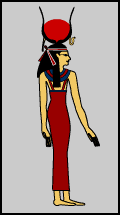Persistence of the Goddess

Hathor was a protective goddess. She was also the goddess of love and joy.
Like a plant that pushes its way up through a patch of macadam, the feminine Goddess continues to reappear even after she has been paved over by male-dominant theologies. And so the feminine principle can be identified even in religions that do not recognize a specifically female deity. Hinduism does acknowledge the feminine manifestations of its male gods in the shakti, or energizing force of the deities; the Absolute Godhead from which all the deities proceed, Brahman, is considered neuter. In China, Taoism has always embraced the feminine principle through its yin-yang philosophy, in which yin represents the dark, cool, feminine elements and yang the light, hot, masculine ones. Lao-tze speaks of a time when yin was not yet ruled by yang, when the Goddess was the original Source of the universe. Quanyin, the bodhisattva of compassion in Chinese Buddhism, has been depicted as feminine from about the 10th century, reflecting the Taoist influence on Buddhism. Like the Christian Mary, Mother of God, Quanyin is often the one to whom childless women turn for help. In Mahayana Buddhism we find not only Prajnaparamita, known as “the Mother of the Buddhas,” the embodiment of one of the greatest Buddhist sutras, but also Tara, an emanation of the bodhisattva of compassion whose Chinese counterpart is Quanyin. Tara, a savior goddess of about the 2nd century, is a popular deity in Tibetan Buddhism, appearing in 21 forms of different colors, postures, and iconographies.
Although the feminine is more suppressed in Judaism, it still appears in the figures of Shekhinah and Hokhmah. Shekhinah is the name for the manifestation of the Divine presence on earth in the tabernacle of the Ark of the Covenant, the burning bush, and other Biblical images. Hokhmah is the Hebrew embodiment of Wisdom (like the Greek Sophia, feminine in gender) who shows up in the Wisdom writings (Ketubim) of the Bible.
Next – The Goddess in the New Age: Earth-based Traditions »


